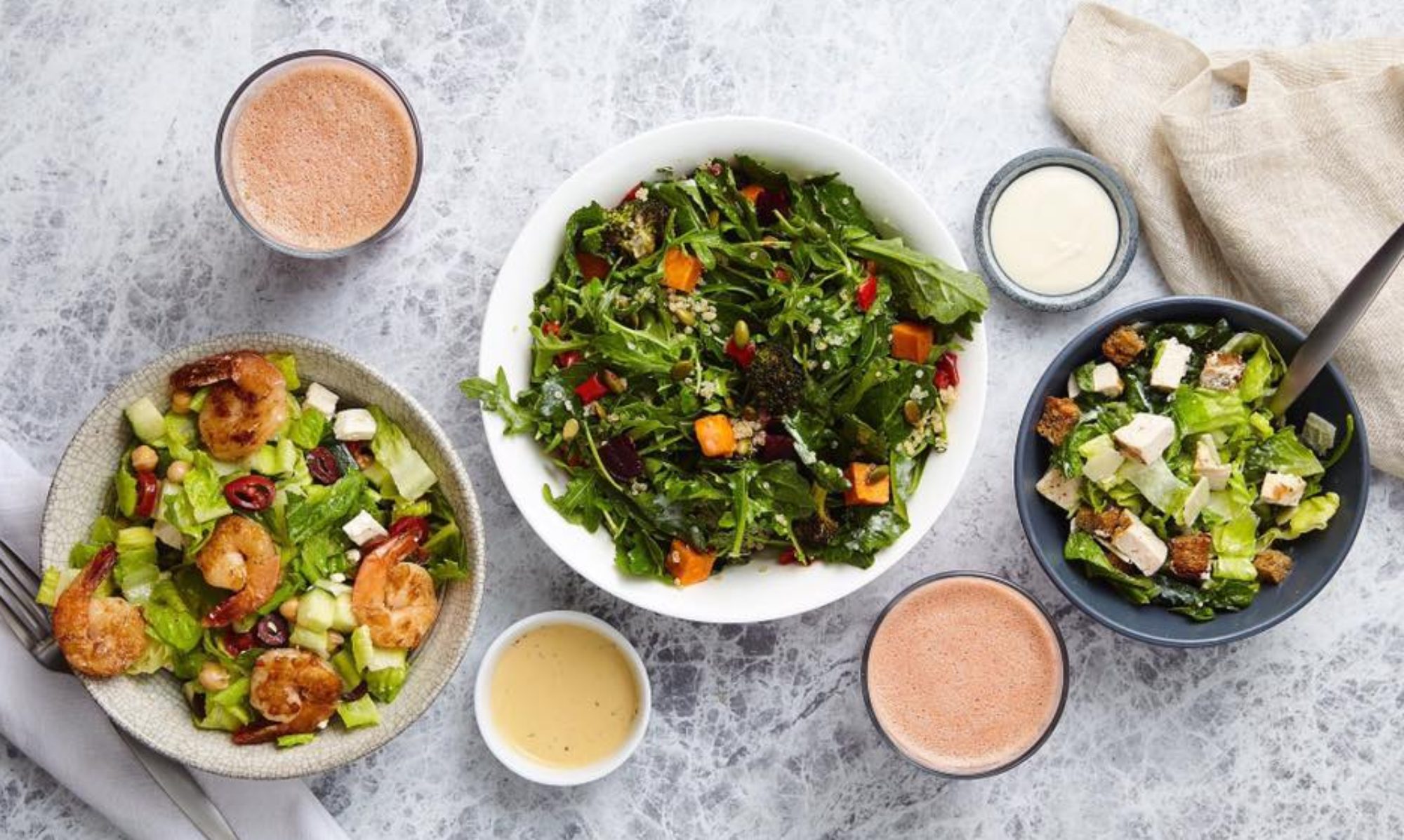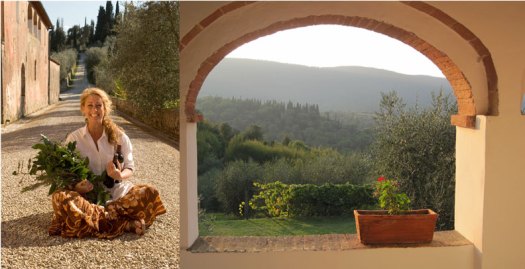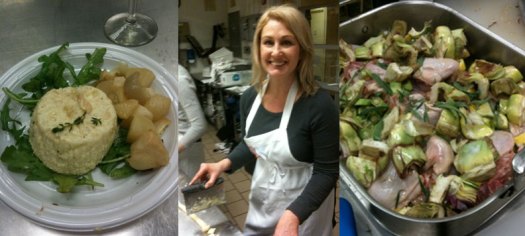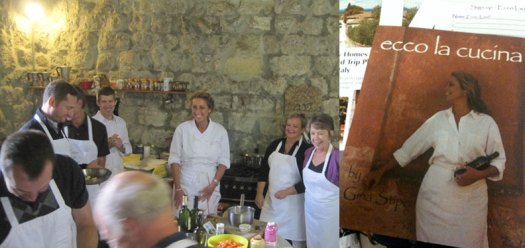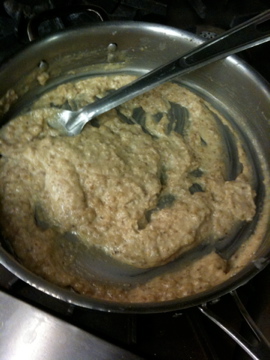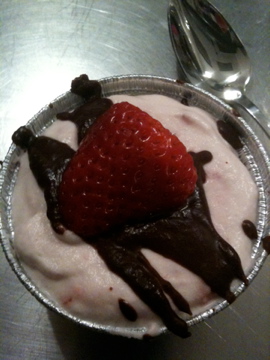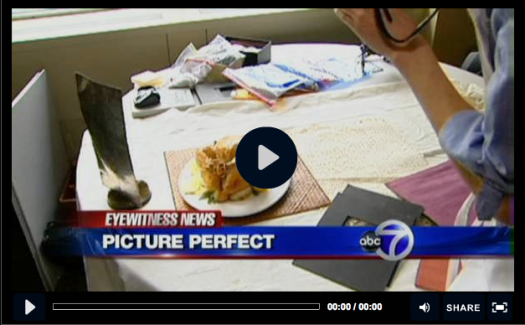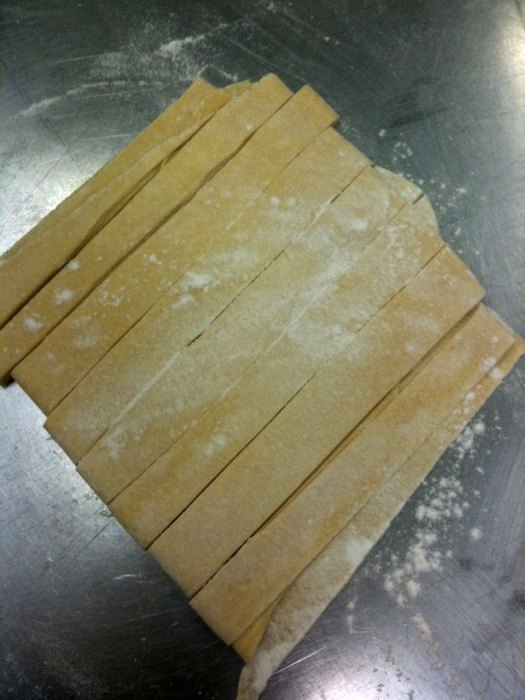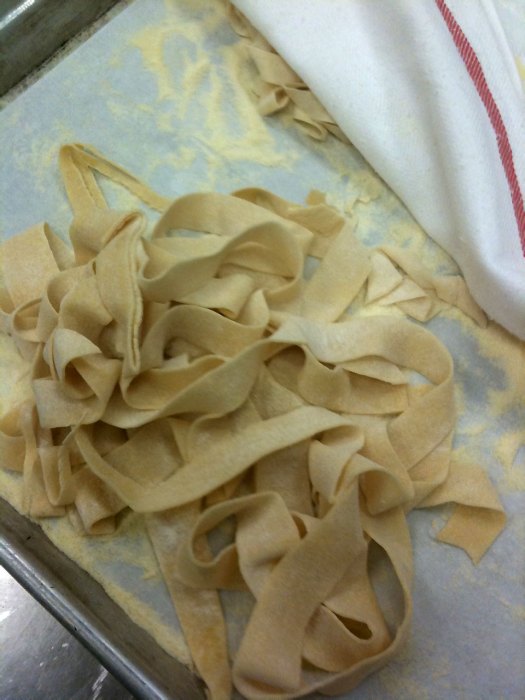
I love Italian food. I mean really loooove Italian food.. And who doesn’t? But especially authentic, homemade Italian – cooked with fresh ingredients and simple, healthy recipes that are downright divine. I recently took a cooking class at the Institute of Culinary Education in New York City with Chef and Culinary Instructor Pia Vallone, who teaches the Techniques of Italian Cooking course. It was a 5-week intensive class 6 hours long. Lots to learn in a short amount of time. Chef Pia, a native of Italy and graduate of ICE, taught us a a variety of recipes from different regions of Italy spanning the basic recipes and techniques.

We made fresh pasta and risottos, hearty ragus and fresh and creamy sauces, roasted and braised meats, seafood dishes, soups and stews,

roasted and braised vegetables (my favorites were the Roasted Tomatoes and Stuffed Wine-braised Artichokes), desserts such as Classic Tiramisu, Mascarpone Mousse and Rustic Italian Apple Crostata,

and healthy, fresh Italian salads and small plates.

We always had red and white Italian wine and fresh Italian bread to accompany, and learned the customs of eating the way the Italians do – start with an “antipasti” (appetizer), next order a “primo” (first course usually consisting of pasta, risotto, minestrone or other soups), then pick your main “secondi” (second course usually a meat or fish dish), have a small bit of “formaggi” (cheese) after your main, then on to “dolci” (sweets/desserts such as cheese, fruit, sweet wine, and coffee/cappucino).

We made some of the most amazing Italian food during this class and learned classic authentic cooking techniques that I was able to bring home with me to prepare my own delicious Italian food. In fact, I was so impressed with Pia’s class that I had to interview her to share her culinary background and story along with a recipe with all of you! Enjoy.
- Can you tell me a little bit about your culinary training and professional background? What was your first job as a Chef and what was that like?
My first and only hands-on restaurant experience was in an Italian restaurant in London (cannot remember the name of the restaurant), near Victoria Station, in the summer of 1978. A friend of mine who worked as an executive chef there, offered me a job as a sous chef. After a month of hard work, I had to leave the restaurant, because my visa was about to expire and soon after, I returned to Italy. The second experience related to food, was working for several years as a bookkeeper for a restaurant and corporate catering. There I learned so much about food and was exposed to new ingredients and flavor profiles, although I worked in the establishment’s office. As for training, I graduated from The Institute of Culinary Education in NYC and hold a Culinary Arts diploma and a Pastry and Baking Arts diploma. I currently work at ICE as a Manager of Kitchen Assistants and as a Recreational Chef Instructor, though I have worked in different areas in the company, within the past 10 years.
- When did you realize you wanted to be a Chef? Who inspired you most as a young cook and what did you learn from them?
I always loved cooking and eating, but I began to spend time experimenting with recipes from various kinds of cuisines in my home kitchen, cooking for friends when I arrived to New York in 1980. Wanting to get involved with food and becoming a chef was a second career change for me, which began in 2001.
My greatest inspiration was my father, who was a gourmand and a terrific cook. I spent many hours in the kitchen with him during my childhood, helping out, observing him and absorbing all the knowledge I could. From my father, I learned passion, love and appreciation of good food and the importance of using fresh ingredients.
- Can you tell us a little bit about your culinary style and what makes your menus and recipes unique?
My style is mainly rustic. I like rustic food for its simplicity and because it is nourishes the body and soul. My menus and recipes are unique, because the ingredients I use are accessible and inexpensive.
- Is there a difference in the recipes you create/the food you eat in Italy versus the Italian food here in the United States and what are the main differences?
The difference between food in Italy and food here…? Food in Italy is extremely fresh, mostly organic and seasonal. Its flavor(s) cannot be replicated in dishes cooked outside of the Country. Food in Italy is also quite simple. In fact, most of the best food I have ever eaten there was prepared with just a few ingredients. On the contrary, Italian American food is the result of ‘imported’ traditions and transformations, mostly due the immigrant’s longing for the ‘Old Country’. Immigrants, who arrived here tried to capture flavors and freeze memories, by utilizing similar ingredients grown in a different terroir. Nowadays though, great Italian chefs live here in the States, so the differences between Italian food in Italy and the US is narrowing down.
- In your opinion, what are the most important elements when creating a recipe from scratch?
The most important elements are: fresh ingredients, simplicity and focus, Make sure to tastes the food while cooking it.
- What is your signature dish or your favorite recipe?
My favorite dish is ‘Roman Style Tripe’, a dish that brings back childhood memories.
- What is your favorite spice or ingredient to cook with and why?
I love black pepper, which I use in all savory recipes. Besides liking its pungent flavor, I add it to dishes because it helps improve digestion.
- What is your favorite cooking gadget or kitchen item you can’t live without and why?
I own many gadgets and often buy the new ones that are the latest invention in the market, but always tend to use the familiar ones over and over. A gadget I cannot live without is a hand held grater, because it is efficient and does not use too much space in the kitchen.
- Do you have any advice for aspiring chefs and home cooks?
Start by cooking a simple recipe, one with 4 or 5 ingredients. Learn basic skills and techniques at first and then move on to a larger repertoire. Patience, practice and repetition are important to achieve success with cooking, as with other things in life.
- Is there anything else you’d like to tell us about yourself?
Yes. I am always looking to inspire others to cook. It is a pleasure to see that people are interested in cooking and familiarizing themselves with ingredients. Sharing passion for food and cooking with people is an all-around relaxing experience for me.

Spring Vegetable Soup
Yield: serves 6
2 small carrots, diced
2 celery stalks, diced
1 yellow onion, chopped
2 small zucchini, diced
1 small butternut squash, diced
1 bunch escarole, chopped
½ cup peas, frozen
1 tablespoon basil leaves, chopped
1 tablespoon parsley, chopped
¼ cup Parmigiano Reggiano, grated
6 tablespoons extra virgin olive oil, plus extra for bread and for drizzling on soup
4 quarts chicken stock
1 small ciabatta bread
Sea salt to taste
Pepper to taste
- Sauté carrots, celery and onions in a large stock pot over medium heat, for approximately 5 minutes, making sure that you stir the vegetables while they cook.
- Add chicken stock to the pan. Increase the heat to high, cover the pan, bring to a boil and then reduce the heat to medium-low. Cook for 10-15 minutes.
- Slice bread into 1” thick slices. Brush slices with the additional olive oil on both sides and place in a sauté pan over low heat. Turn bread slices once and cook until they are golden brown. Place bread in a tray and lightly sprinkle with sea salt. Set aside.
- Add butternut squash to the stockpot and cook for 3 minutes.
- Add zucchini and peas to the stockpot and cook for 3 more minutes.
- Add escarole, basil, parsley, salt and pepper and cook for 4 additional minutes.
- Remove two ladles of soup from the stockpot and puree in a blender, then return the pureed soup to the pot (the puree will thicken the soup). Stir and cook for 1 minute, then turn off the heat.
- Add some grated cheese into the soup and stir. Ladle soup in individual bowls, drizzle oil and sprinkle additional cheese.
Recipe Copyright © Pia Vallone 2010.
Photo credits: Kristen Hess and Pia Vallone.
